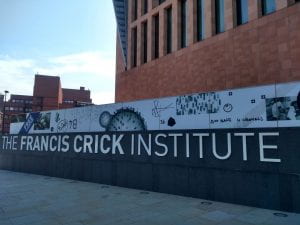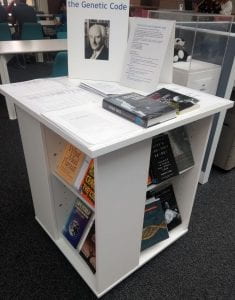On the second hottest day on record I headed over to St Pancras to the Francis Crick Institute. Fortunately they had air conditioning! The Francis Crick Institute is a really interesting place. It is a pure research institution. It was launched in 2007 by Gordon Brown and founded by joining Cancer Research UK and the Medical Research Council (MRC) and the Wellcome, UCL, Imperial College London and King’s College London are all also partners. The Francis Crick Institute moved into its new building next to the British Library in 2016. Its focus is on researching the biology underlying human health.
The Library and Information Service is particularly interesting because they have no physical library space and they have come up with various strategies to deal with this. They are part of Information Technology and Services (ITS). The Library and Information Service concentrates on scientific information and training. There is a big emphasis on supporting open access/open research. Due to the nature of the institution they have a lot of people coming through and moving on. Online journals are a very important resource. There is no book collection on site and having to rely on e-books can be problematic. Portable books displays are set up on the laboratory floors focusing on areas like the history of science to give a broader and deeper understanding.
There are only four staff in the Library and Information Service so they all do a bit of everything but do each have specialities. There is plans for cross-skilling and also to upskill the ITS help desk so they can solve common queries. Library staff get a slot in inductions even if it can be very short and they make contact with new staff by email. It is compulsory for PhD students to attend a citation management course within six months of starting. Once a week each member of staff spends a morning on the one of the laboratory floors. They also run lunch time breakout sessions. They have found that having something visual is a great way to get conversations started.
The whole idea behind the institute is collaboration and the building has been designed with this in mind. The only clustering of research groups is around lab equipment and there are lots of places for people to interact and talk science including the canteen becoming a bar a few nights a week! A lot of consideration has been given to the neighbours. The building includes a space for community use and there is also a schools lab. The target is to have contact with every single student in Camden once every year. The building was also designed to have minimal impact on the environment. Processes are in place to minimise delivery traffic and there are green roofs and solar panels.
If we ever want to upgrade our barriers and stop any tailgating, we could look at installing access pods like they have at the Francis Crick Institute. These only let a single person through at a time using weight to check only one person is inside before opening the door to get out the other side.



